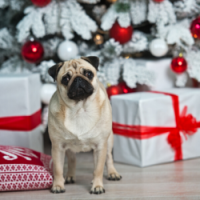Losing a pet is tough. It’s tough on every member of the family, including the other pets. While our canine and feline family members may not fully grasp the significance of death, it’s clear that they grieve in their own individual way. That makes it especially tough on us. While we mourn the loss of one pet, we must also be aware of how this loss affects our other pets.
Why do pets grieve?
Pets develop relationships. They bond with human and non-human family members alike. Since their world is fairly confined to the home environment, these family relationships are the center of their universe. Pets see family members, human or otherwise, as a pack much as their ancestors did in the wild. They depend on the pack for a sense of safety and well-being. When one member of the pack dies, the surviving pets may feel unbalanced.
“Pets see family members, human or otherwise, as a pack much as their ancestors did in the wild.”
Pets recognize their position in the family and find comfort in the stability of the pack. The death of a pack member disrupts the family unit. A pet’s response to changes in his pack may manifest as grief. The surviving pet may exhibit signs of distress and anxiety or develop behavior issues. Grieving the actual loss of a pack member is bad enough. To make matters worse, our pets also respond to our sadness as we personally mourn the loss.
To put pet grief in relatable terms, pets, especially dogs, respond to loss much like human toddlers. They may not totally understand the concept of death as an everlasting separation, but recognize and feel a current sense of loss.
How can I recognize if my pet is experiencing grief?
Our pets don’t verbalize their thoughts, so how do we know they are grieving? We observe their behavior changes. A study conducted by the ASPCA showed that more than 60% of pets experience four or more behavioral changes after losing a companion.
Here are signs that your pet may be grieving:
Changes in appetite. Many pets eat less following the loss of a furry friend, especially if the deceased was the “leader” of the pack. The leader, especially in dog families, usually controls mealtime, and the other dogs “follow the leader” to the food bowls. Without the alpha dog to initiate feeding, the mealtime routine is disrupted, and the surviving dog may eat less. According to a study in New Zealand, about 30% of pets have decreased appetite after losing a companion.
Changes in vocalization. Cats and dogs may bark, meow, or howl more than usual. After the loss of a companion, cats are more likely to increase their noise making than are dogs, but both may whine. Watch for increases and decreases in vocalizations. If your dog usually barks at the postman and suddenly stops, take heed.
Changes in habits. Some pets sleep more than usual. In a New Zealand study, about 30% of grieving dogs and 20% of cats napped more. Other habits may change, too. For example, some pets pace about constantly, some hide, and some sulk.
Changes in personality. In this same study, about 60% of dogs and cats clung more to humans after the loss of a pack member. On the other hand, some may become withdrawn. They may lack interest in play time. Others may show signs of separation anxiety or become destructive in the house.
Changes in grooming or bathroom habits. If your normally fastidious pet soils the house or misses the litter box, this should raise a red flag. If your cat or dog doesn’t groom himself, take note. He could be grieving.
Seeking behavior. Approximately 60% of pets repeatedly look for lost companions in their normal napping spots. If your pet constantly returns to his deceased friend’s favorite sleeping or resting place, he may be brokenhearted.
How can I help my grieving pet?
As an important member of the pack, you can help your pet through the grief cycle. Try some of these tips to lift your pet’s spirits.
Provide closure. Pets have a limited understanding of death as finality. It’s tough, but if possible, let your pet see the body of his deceased friend. He may not totally grasp the situation, but one last visit may help him understand that his pal is gone. Some behaviorists think that a dog’s grief response may be reduced by having an opportunity to investigate the deceased.
Control your emotions. It’s instinctive to lean on your pet for comfort as you process your own grief, but try not to become too emotional in front of your pet. Your pet is sensitive to your feelings and your grief may add to his distress. It’s fine to allow your pet to console you, but try to be aware of his response to your emotions. Try to talk to your pet in an upbeat voice even when you are sad.
Allow time for adjustment. With the loss of a family member, the pack is disrupted and the household dynamic is temporarily unstable. In multi-pet households, it is important for the remaining pack members to establish a new social structure. Let your pets work things out for themselves. Only intervene if their restructuring becomes dangerous. No fighting allowed! In households with two pets, the sole survivor may be lonesome, but you should avoid your natural tendency to immediately get another pet. A new pack member may only add more stress. It’s best to adjust to the new normal first.
Spend quality time with your pet. Spending time with your pet during the grieving process is important, but as you and your pet comfort each other, be careful not to reinforce unwanted behaviors. As hard as it is, you need to fight your parental instinct to soothe your pet as he whines or paces incessantly or mopes around. It’s best to ignore these behaviors and choose times when he is quiet to shower him with TLC.
Try something new. The pack has changed, so now is a good time to introduce new things. Find a new challenge that will distract your pet from his sadness and teach him something at the same time. Buy an interactive feeding toy, walk on a different trail, or visit a new dog park.
Respect the old. New things are fine, but pets like basic routines. Try to keep the household on track despite the disruption by keeping daily schedules as consistent as possible. Regularly scheduled mealtime, exercise time, play time, and bedtime will help your pet feel more secure. There’s comfort in familiarity.
Seek outside help. If your pet doesn’t eat for several days, call your veterinarian to avoid major health problems. Continued behavior changes like depression or anxiety should also be addressed. A behavior consultant can provide methods to facilitate the re-establishment of a happy household. There are also medical therapies and pheromones that may improve your pet’s attitude.
This Too Shall Pass…
Losing a pet is difficult for the entire household. It’s especially hard for loving pet owners because they have to deal with their own sense of loss while watching their remaining pet or pets grieve. Double whammy!
There is a silver lining to this sad cloud. Caring for your grieving pet may help you process your own loss and find quicker healing. It may also strengthen the bond between you and your furry friend as you walk this sad path together.
© Copyright 2020 LifeLearn Inc. Used and/or modified with permission under license.






